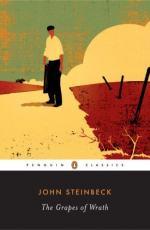|
This section contains 6,432 words (approx. 22 pages at 300 words per page) |

|
SOURCE: Cederstrom, Lorelei. “The ‘Great Mother’ in The Grapes of Wrath.” In Steinbeck and the Environment: Interdisciplinary Approaches, edited by Susan F. Beegel, Susan Shillinglaw, and Wesley N. Tiffney Jr., pp. 76-91. Tuscaloosa: University of Alabama Press, 1997.
In the following essay, Cederstrom argues that the final scene of The Grapes of Wrath is not derived from Christian symbolism, as has been asserted, but rather from earlier pagan notions of the “Great Mother” and traces evidence of matriarchal ideals throughout the novel.
In his depiction of the destruction of the fertile earth and the lives of those who have depended upon her abundance, John Steinbeck in The Grapes of Wrath presents a visionary foreshadowing of the universal ecological disaster that looms so prominently on the horizon today. Equally visionary is his evocation of the primordial alternative to the patriarchal structures and attitudes that are destroying the earth. Throughout the...
|
This section contains 6,432 words (approx. 22 pages at 300 words per page) |

|


